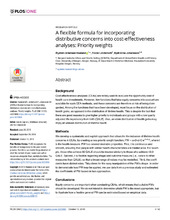| dc.description.abstract | Background Cost effectiveness analyses (CEAs) are widely used to evaluate the opportunity cost of health care investments. However, few functions that take equity concerns into account are available for such CEA methods, and these concerns are therefore at risk of being disregarded. Among the functions that have been developed, most focus on the distribution of health gains, as opposed to the distribution of lifetime health. This is despite the fact that there are good reasons to give higher priority to individuals and groups with a low quality adjusted life expectancy from birth (QALE). Also, an even distribution of health gains may imply an uneven distribution of lifetime health. Methods We develop a systematic and explicit approach that allows for the inclusion of lifetime health concerns in CEAs, by creating a new priority weight function, PW = α+(t-γ)·C·e-β·(t-γ), where t is the health measure. PW has several desirable properties. First, it is continuous and smooth, ensuring that people with similar health characteristics are treated alike. For example, those who achieve 50 QALE should be treated similarly to those who achieve 49.9 QALE. Second, it is flexible regarding shape and outcome measure (i.e., caters to other measures than QALE), so that a broad range of values may be modelled. Third, the coefficients have distinct roles. This allows for the easy manipulation of the PW’s shape. In order to demonstrate how PW may be applied, we use data from a previous study and estimated the coefficients of PW based on two approaches. Conclusions Equity concerns are important when conducting CEAs, which means that suitable PWs should be developed. We do not intend to determine which PW is the most appropriate, but to illustrate how a flexible general PW can be estimated based on empirical data. | en_US |

